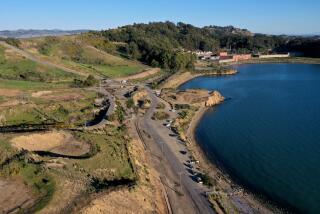New beach hours at Dana Point development alarm users
- Share via
After a decades-long struggle to win approval for a 121-acre gated community of 118 homes and a resort on a commanding bluff in Dana Point, developers made extraordinary concessions for public access, including four access points and an inclined railway called a “funicular” that shuttles visitors to a secluded beach known as the Strand.
But now that the bluff-top lots, marketed as the “last undeveloped oceanfront property” in Southern California, have started to sell for as much as $12 million, locked metal gates have gone up and signs posting hours have appeared at the top of the stairways: “Coastal Access (Limited to Sidewalk) 8:00 a.m. - 5:00 p.m.,” the signs read.
Champions of beach access, including the conservationists and surfers who opposed the project for years, have cried foul, saying the barriers bar them admission to one of Orange County’s great beaches and surf spots if they come at the wrong time.
“They made this grand balancing act to justify this project, and now they’re chipping away at the public benefits,” said Chad Nelsen, environmental director of the Surf- rider Foundation.
The California Coastal Commission is investigating the gates and hours of operation to determine whether they violate the development permit or state law, which requires the maximization of hours of use for public beach access and recreation. Late last year the agency wrote to express its concerns to Dana Point, which manages the stairways.
Sanford Edward, president of Headlands Reserve, the developer, declined to discuss the posted hours. “I’m unavailable,” he said before hanging up.
“Mostly it has to do with privacy after-hours,” said Carol Finizza, a spokeswoman for the company, who cited concerns about visitors wandering off the pathway in the darkness of the early morning and evening.
The debut of the long-awaited pathways to the Strand highlights the difficulties in balancing public beach access with the expectation of privacy in a gated community where the wealthy drop millions for a an ocean-wave view.
“It pits private property ownership up against the right to get to that wet sand that is in our Constitution,” said Fran Gibson, board president of Coastwalk California, a nonprofit coastal protection and access group that says the posted hours require permission from the state. “Nowhere on the coast of California can you limit the hours just willy-nilly.”
City officials say the development agreement gives Dana Point the right to set hours, mostly to guarantee public safety.
“You obviously don’t want people walking in the dark along the trail,” said City Manager Douglas Chotkevys.
Chotkevys called the development a scaled-back compromise that provides an unheard-of amount of public amenities, including new trails, open space and a panoramic overlook with lush greenery called Strand Vista Park, where view-blocking hedges and a trailer park used to sit, all while giving the developer a chance for a “substantial” return on its investment.
“You had a private beach with no access, and now you have five ways of getting there,” he said. “It’s a gated community, and you can walk through it.”
The Coastal Commission approved the project in 2004, but only after a decades-long legal, legislative and environmental battle.
At the time, conservationists, including the Sierra Club and Surfrider, decried it as a “catastrophic” loss of a treasured coastal promontory.
With those battles in the past, surfers now marvel at the ease with which they can get to the beach by descending long stairways.
But they are frustrated, Nelsen said, that they are being barred from using them for early morning forays into the waves or sunset surfing, although the closing time will be extended to 7 p.m. in the summer.
For comparison, another staircase just down the coast of Strand Beach, operated by Orange County’s parks agency, is closed from midnight to 5 a.m.
But those long-standing limitations haven’t generated the outcry of those at the pathways through the new development.
Nelsen, for instance, reported that security guards riding golf carts have harassed and tried to ward off surfers as they walk down to the beach.
A spokeswoman for the developer, however, said reports of rousting are false.
With the down economy, populating the oceanfront lots with custom-built homes has been slow-going; only a few houses have been built, and 85 lots have yet to be sold.
Eventually, the largest, most secluded parcel is expected to go for $17 million, which has some conservationists seeing a different reason for the barriers to access: elitism.
“We see this up and down the coast,” said Gibson, the Coastwalk California president.
“That when there’s a gated, private community given to expensive, large homes, there’s this sense of ‘this beach is mine,’ ” Gibson said.
More to Read
Sign up for Essential California
The most important California stories and recommendations in your inbox every morning.
You may occasionally receive promotional content from the Los Angeles Times.











